Once upon a time there was an old man and an old woman, they had a daughter, Alyonushka, and a son, Ivanushka. An old man...

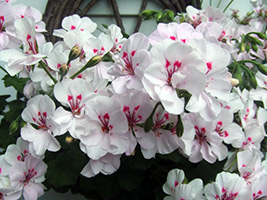
Beginning flower growers are often treated with caution when growing pelargoniums. For some, these plants are associated with capricious ones that require increased attention, for others, with elongated shoots of the "grandmother's ball", which is poorly pleasing with lonely panicles of flowers with a sugary-dense smell. Fortunately, acquaintance with ivy-leaved pelargonium can radically change this attitude towards these long-familiar, but still very relevant houseplants. The ampelous growth of ivy-leaved pelargonium, combined with endurance and unpretentiousness, makes it the most “universal” in terms of use against the background of other species, because in terms of abundance, and even more so for the duration of flowering, it can “push behind the belt” even many “royal” varieties.
In literary sources, this plant is found under the names of pelargonium ivy (Ivy-leaved pelargonium), or thyroid (Pelargonium peltatum), and among the people it appears as a cascading (cascading geranium - Eng.), Hanging or simply ampelous pelargonium. Judging by the names, the main features of ivy pelargonium could be considered the free growth of long hanging shoots and ivy-like leaves (“Ivy” translated from English as “ivy”) leaves, but not all of its varieties have such characteristics. Since the appearance on the market of the first grade ("Ville de Paris", 1786), obtained by crossing the p. thyroid (P. peltatum) with the p. faceted (P. laterites), until early XIX centuries, only newly obtained varieties were involved in the process of hybridization. But the "introduction" into the crossing of specimens of zonal and royal pelargonium and the appearance of the first terry variety "Madame Crousse" brought this plant to new round popularity. Today, the group of ivy-leaved pelargoniums includes evergreen ampelous miniature (stem length no more than 25 cm), compact and vigorous (up to 150 cm) plants with thin, drooping or creeping shoots and dense shiny leaves. In most varieties, the leaves have a pronounced ivy-like shape and are monophonic. green color("Ville de Paris", "Amelit", "Jacky Gauld", "Amethyst"), but in some they are very similar to the leaves of zonal ancestors, not only in shape, but also in color - with a concentric pattern of brown or bronze hues ("Ivy Scarlet ”, “Ivy Arctic Red”, “Mauve Beauty”, etc.). An absolutely stunning effect is produced by variegated varieties with leaves decorated with white-golden venation ("Crocodile", "Crock-o-Day", "Cotta Rio Grande", "Crocketta"), chaotic spots ("Wood "s Surprise", "Variegated Giroflee") or edging ("Dancing Queen", "Evka", "Variegated Bonito"). If we add to all of the above that in some varieties of ivy pelargonium the leaves also have a pleasant aroma, then it can be argued that these plants can be a godsend for lovers of both zonal and variegated, and fragrant pelargoniums.
Please note: not all trailing pelargoniums (having ampelous growth) belong to ivy. So, in particular, ampelous varieties with long, not rigid, cascading stems are also among the Angelic Pelargoniums - "Wychwood", "Rose Bengal", "Veronica Contreras", "Rollers Shadow" and "Darmsden". Despite the fact that in the spring-autumn period, in unpretentiousness, these plants are not much inferior to ivy-leaved relatives, they make increased demands for wintering, like “royal” specimens. By the way, some flower growers tend to believe that outwardly Angelic pelargoniums are significantly inferior to ivy-leaved ones due to smaller leaves and flowers similar to pansies, but this, as they say, is a matter of taste.
 A common feature for all ivy-leaved pelargoniums can be considered long (on average 12 - 18 cm) peduncles, bearing 5 - 8 flowers in umbellate inflorescences. Flowers can be simple, butterfly-like ("Cascade Pink", "Tornado Lilac", "Tornado Rose"), semi-double ("Blanche Roche", "Tomcat"), double, reminiscent of azalea flowers or ("Mrs. Martin", "Amelit", "Amethyst"), and even pronounced rose-like ones ("Chiffon", "Ice Rose", "Jackie", "Lilac Rose", "Sybil Holmes", etc.). The color includes the richest range from delicate white, pink and lilac to rich red, purple and burgundy shades in both monophonic and two-tone variations in the form of either contrasting strokes / edging on the petals ("Crock-o-Day", "Rouletta", "Crocketta", "Harlequin Miss Liver Bird", "Harlequin Rosy O "Day"), or the color selection of stamens against the general background of the flower ("Blanche Roche"). In South Africa - on its historical homeland- Ivy pelargonium usually blooms in autumn (September - November), and in our climate - from May to the end of August. Due to pinching / pruning, the flowering time may shift, but, as practice shows, with sufficient lighting, this plant blooms willingly even in winter. Of course, a single flower or inflorescence of ivy-leaved pelargonium in size can greatly lose to royal specimens, but if we compare the bushes during flowering in general, the ivy-leaved one wins in the number of flowers due to the volume of green mass and inflorescences forming a flowering cloud.
A common feature for all ivy-leaved pelargoniums can be considered long (on average 12 - 18 cm) peduncles, bearing 5 - 8 flowers in umbellate inflorescences. Flowers can be simple, butterfly-like ("Cascade Pink", "Tornado Lilac", "Tornado Rose"), semi-double ("Blanche Roche", "Tomcat"), double, reminiscent of azalea flowers or ("Mrs. Martin", "Amelit", "Amethyst"), and even pronounced rose-like ones ("Chiffon", "Ice Rose", "Jackie", "Lilac Rose", "Sybil Holmes", etc.). The color includes the richest range from delicate white, pink and lilac to rich red, purple and burgundy shades in both monophonic and two-tone variations in the form of either contrasting strokes / edging on the petals ("Crock-o-Day", "Rouletta", "Crocketta", "Harlequin Miss Liver Bird", "Harlequin Rosy O "Day"), or the color selection of stamens against the general background of the flower ("Blanche Roche"). In South Africa - on its historical homeland- Ivy pelargonium usually blooms in autumn (September - November), and in our climate - from May to the end of August. Due to pinching / pruning, the flowering time may shift, but, as practice shows, with sufficient lighting, this plant blooms willingly even in winter. Of course, a single flower or inflorescence of ivy-leaved pelargonium in size can greatly lose to royal specimens, but if we compare the bushes during flowering in general, the ivy-leaved one wins in the number of flowers due to the volume of green mass and inflorescences forming a flowering cloud.
Interestingly, many flower growers appreciate the ivy-leaved pelargonium because it grows many shoots and blooms profusely in a small pot, without requiring regular transplantation into a large container, like most indoor plants. This makes her one of best plants for hanging baskets and planters. And its high resistance to temperature extremes, heat and drought allows it to be planted also in balcony containers and outdoor window boxes for showcases, verandas and balustrades. In this case, the greatest decorative effect, as a rule, is achieved by planting several contrasting varieties in a common container - during flowering, they create an unforgettable look of a “motley waterfall”. In the conditions of a modest window sill, a similar effect can be created by growing vigorous, actively branching varieties (Antik Peach, Amethyst, Cascade Pink, Drezden Apricot) on a trellis. To do this, in the spring, with the beginning of active growth, you need to pinch the plant short enough on one side (to insert the grate into the pot as close to the center as possible) and put it in a permanent, well-lit place with the grate against the wall. As the shoots grow, they should be carefully fixed on the trellis with plastic garters, while constantly holding forming pinches. As a rule, ivy-leaved pelargoniums grown in this way easily outgrow a trellis 1 m high until autumn, but due to regular pinching, they usually bloom later than their "balcony sisters".
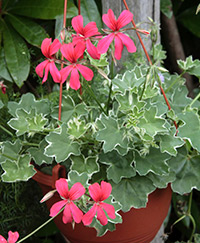
By the way, the options for using pelargonium ivy are not limited to this. As practice has shown, under conditions southern climate it can serve as an original: like zonal pelargoniums, ivy with the onset of sustained heat can be planted in open ground. However, it should be borne in mind that a lot of space is required for its growth - it does not tolerate close proximity to other plants at all (shading, thickening). And it is advisable to land in the ground without removing the pelargonium from the pot, otherwise it will actively branch and grow to the detriment of flowering. Despite the fact that this plant tolerates temperatures down to +5 ° C without problems, even minimal frosts are already detrimental to it, so for the winter the ivy-leaved pelargonium will still have to be dug out of the ground and transferred to the room.
It is very unusual and very original to grow this pelargonium on a bole, but this method is more suitable for already experienced flower growers who own the “art of grafting”. The closest relatives of the ivy - zonal pelargonium - are considered an excellent stock for her, so powerful tall varieties are ideal as a trunk. The vaccination procedure is recommended in early spring(March), and for rootstock and scion it is better to choose plants of approximately the same age, otherwise characteristics older plants will later become dominant. It is interesting that this method allows you to plant cuttings of several varieties on one rootstock and as a result get a lush “tree” that blooms in two shades - why not in miniature? The easiest way to graft is to make 1 - 1.5 cm identical oblique cuts on the stem of the rootstock and the stalk of the scion, combine them and fix them tightly with plastic tape or thick woolen thread so that they do not move. It is advisable to carry out the procedure as quickly as possible and use a disinfected instrument. A week after this, the plant should be kept in dark place in a greenhouse (or with a plastic bag tied to the top of the stem). Then organize regular ventilation and after 3 days transfer the pelargonium to the usual room conditions, but not under direct Sun rays, since the complete fusion will be completed on average only after 3 weeks.
It is possible to grow ivy-leaved pelargonium, as well as zonal, either from seeds or from cuttings that readily take root in the ground. When growing from seeds, the biggest problem is probably their purchase, since in flower shops they don't do it often. Sow them in bowls with a wet mixture of peat, soddy soil and sand (1: 1: 1) with additional lighting, you can already in late autumn - winter. Seed sowing depth - maximum 5 mm, germination time in a greenhouse from high humidity, temperature 22 - 24 ° C and periodic ventilation - 1 - 3 weeks (depending on the quality of the seeds). 2-3 weeks after germination, seedlings can be dived into separate 5-cm pots, with the onset of active growth, begin to feed them with complex mineral fertilizers in very small doses and, if necessary, transfer them to large containers. When planting several pelargoniums in a common pot, you need to consider that for one mature plant should account for an average of no more than 1 liter of soil mixture volume, and it is advisable to plant them in a common balcony container at a distance of at least 15 cm from each other or in checkerboard pattern, or along the edge of the pot. Since the ivy plants grown from pelargonium seeds bloom on average after a year and need mandatory winter lighting, it is much more profitable for flower growers to propagate these plants by cuttings. As practice confirms, this method of reproduction often turns out to be also the only option for preserving pelargoniums in winter period.
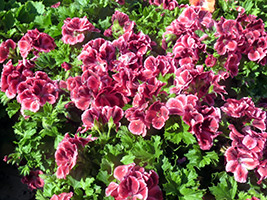
Please note: if the plants are subsequently used as balcony or garden plants, they must be hardened off before planting - gradually accustomed to sunlight. With any method of cultivation, it should be borne in mind that ivy-leaved pelargoniums (including seedlings and young plants) tolerate drought and heat better than dampness and waterlogging of the substrate, which provoke the appearance of diseases and pests. Of particular danger to specimens growing in the open field and on the balcony are the so-called "rainy seasons": due to the constant dampness of the substrate, thickenings and "scars" are formed on the back of the pelargonium leaves, merging into large spots. This edema is a disease that is treated by an elementary regulation of the watering-drying regime, but, unfortunately, it is not always possible to provide its “street” specimens. To prevent this disease, all ivy-leaved pelargoniums are recommended to be watered only after the earthen coma has completely dried. Note: in the summer, on a south-facing balcony, they will not only have to be watered daily, but also periodically (not constantly!) Sprayed in the evening.
The ivy-leaved pelargoniums are not only tolerant of bright lighting, but they constantly need it, since the lack of light causes them to stop growing and fall off the leaves until the shoots are completely exposed, not to mention the absence of flowering. This is especially pronounced on “street” specimens transferred indoors and during their wintering at home: without additional lighting, many plants take on a miserable appearance by spring, and some even die. If the suspension of the growth of ivy-leaved pelargonium is observed with sufficient lighting, the reason should be sought in the inappropriate acidity of the substrate. It is recommended to keep it between 6.0 - 6.5 pH, which is easily achieved by adding soil mixture annually and transplanting every 2 years. Otherwise, the digestibility of the roots is disturbed. nutrients even in the case of their regular receipt in the form of top dressing. By the way, healthy ivy-leaved pelargoniums should be fed every 7 to 10 days with fertilizers for balcony plants or special fertilizers for pelargoniums (Biomaster, Kemira-Lux, Pelargovit, etc.). Infusion can also serve as a good top dressing and prevention from pests. onion peel. To prepare it, you need to pour 4 handfuls of onion peel with a bucket of boiling water, leave for 2 days, and then dissolve 1.5 liters of this infusion in a bucket of clean water and use it for periodic watering / fertilizing or spraying plants.
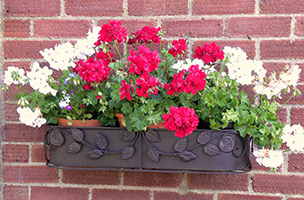
The most difficult in the content of ivy pelargoniums, perhaps, can be considered the winter period. On the one hand, when creating additional lighting, it is very problematic to place a group of vigorous specimens with meter-long shoots in a room - after all, under such conditions, they will continue to grow even in winter. On the other hand, in order to stop stretching in low light, it is desirable to reduce the temperature of the content to 10 - 15 ° C, which is also difficult to do in a living room. Ideally "street and balcony" plants better in autumn(before the onset of frost) cut, leaving "stumps" of 10 - 12 cm, dig out, place in a common container or plastic bag, sprinkling the roots with moist soil, and transfer to a cool (5 - 10 ° C), but bright room (attic, glazed loggia, in extreme cases - the basement). If possible, containers (pots) can be moved with plants without digging them up. It is very important to take care of the protection against rodents, because mice can completely destroy valuable planting material. The cuttings obtained as a result of pruning should be rooted and provided with a relatively cool content (16 - 18 ° C) and until the end of winter. In the spring, with the beginning of the growing season, the overwintered mother plants will need to be planted in a fresh soil substrate and gradually accustomed to new conditions. This technique allows you to provide a compact wintering for several plants at once, and in case of their death, preserve the varieties in the form of rooted cuttings. If there are no other options besides wintering in the apartment, it is recommended to place the ivy-leaved pelargoniums suspended in a flowerpot (away from the radiators) on the very bright window. At the same time, it is advisable to transfer the strong pruning of plants to spring, and in the fall to shorten the shoots only partially (root the cuttings too) in order to prevent the occurrence of diseases due to poor ventilation and depletion of the plant. If by spring the pelargoniums are still very stretched out, you will have to carry out another pruning to give them the desired shape and stimulate branching. Remember: ivy-leaved pelargoniums need to be watered very sparingly during wintering, because dampness and coolness create ideal conditions for the development of fungal diseases.
As you can see, the ivy-leaved pelargonium has much less disadvantages than its advantages, and its cultivation will not be a problem even for beginner flower growers. And since the options for "application" and winter storage there are several of this plant, it’s a sin not to try to use at least one of them in order to acquire, to the envy of all the neighbors, a chic “blooming waterfall” on a trunk, trellis or just in a balcony container.
Ivy Pelargonium (Pelargonium peltatum) gained popularity recently. This plant belongs to the ampelous. This culture will make a wonderful window decoration and will look great in hanging vases and planters.
Ampel ivy pelargonium (geranium) perfect in vertical gardening . If you plant a plant on garden plot, then it forms a continuous flower carpet.
Pelargonium has such a name due to the leaves that reminiscent of ivy leaves. They are quite firm to the touch. Therefore, they are often confused with artificial ones. They differ from the leaves of a simple geranium with a smooth surface.
This type of geranium does not differ in excessive whims, however, like other plants, it requires care. The birthplace of culture is South Africa.
Shoots reach a length of up to 90 cm. The flowers may be in the form of a cactus or an asterisk. They are collected in small inflorescences.
Colors of flowers are various: white, pink, lilac, purple. Pelargonium also has two-color, with a border or with strokes flowers.
The main difference between ivy geranium and ordinary geranium is that this geranium is ampelous. This suggests that its shoots are not erect, but hang down.
In addition, the shoots of ampelous plants are very long, for example, in this plant they reach a length of up to 90 cm. In ordinary geraniums, the shoots are low.
The difference is in the leaves.. If in ordinary pelargonium the leaves have a rough surface and seem to be covered with fluff, then in ampelous leaves are smooth and even.
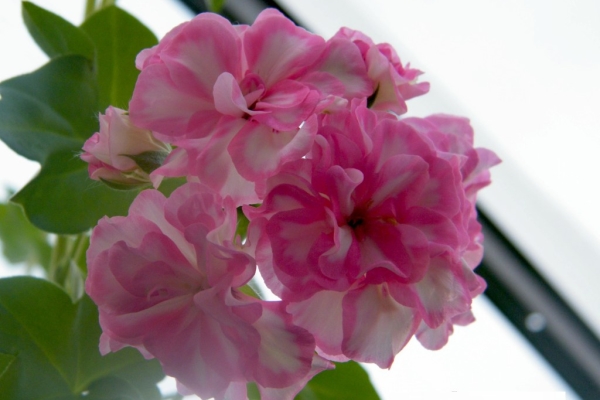
Caring for a plant is not as difficult as it might seem at first glance. It is only important to follow a number of rules.
Since the ivy culture comes from African countries, she loves sunshine and warmth. Therefore, if the plant is grown at home - in a house or apartment - then you should choose a south window.
The bright sun and long daylight hours ensure long-term flowering of pelargonium, the splendor of inflorescences and the rich color of the leaves.
The culture tolerates drought well, so in summer the plant feels great on open loggias and in the garden.
The ideal temperature for growing ivy geraniums is 20-25 degrees.
However, even in hotter times, the flower does not lose its decorative properties. It is enough to water the plant qualitatively and abundantly.
The optimum temperature in winter time-15 degrees. To endure cold snaps, ampelous pelargonium must be hardened. However, the plant does not tolerate frost.
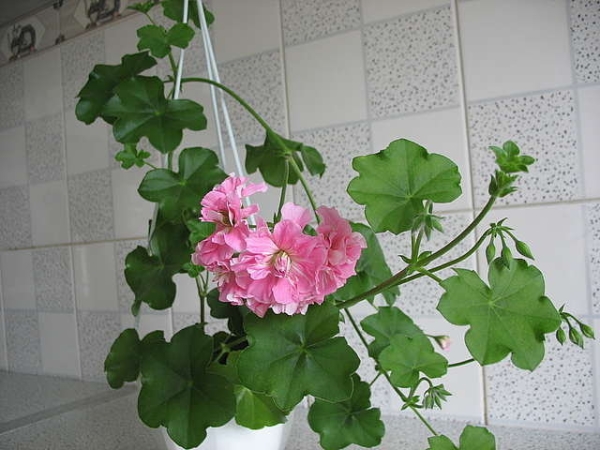
During hot periods, geraniums require frequent watering.. But do not overfill the flower, as stagnant water in the pot will lead to the formation of mold. Drainage is recommended to prevent mold.
With the advent of cold weather, the irrigation regime needs to be changed. In winter, it is enough to water the plant once every two weeks.
It is impossible to spray castings of pelargonium ivy. This is due to their inability to moisture. Water contact with them can cause a number of diseases, including decay.
This culture prefers fertile soil . To prepare the ideal soil for ivy geranium, you need to take in equal parts:
You should not choose too much capacity for the plant. It is recommended to leave no more than 2 cm between the rhizome and the walls of the planter or pot.
Also, this culture loves top dressing. It is recommended to feed it during the flowering period.. Mixtures of potassium and phosphorus are used as top dressings.
Various complex additives are also used, where these microelements predominate. In addition, it is good to feed geraniums with magnesium sulfate. Magnesium and sulfur contribute to the long-term formation of buds.
If the soil is excessively rich in nitrogen, then the bushes and leaves will grow very actively, while flowering will be scarce. However, the abundant growth of greenery can provoke not only a large amount of nitrogen, but also an excessively large pot.
It is advisable to feed the plant once a week. Mineral and organic fertilizers it is desirable to alternate. But nitrogen supplements should not be carried away.
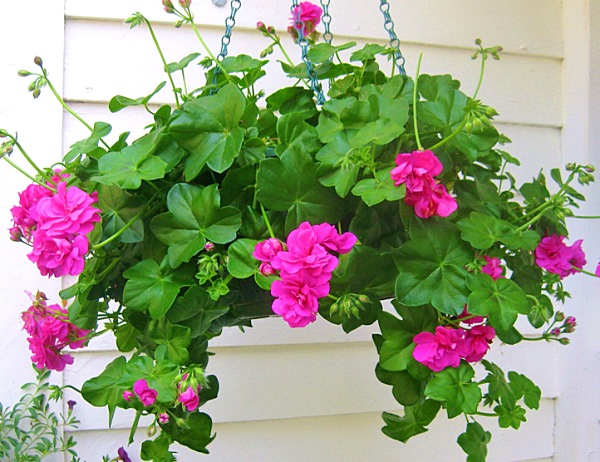
This variety of pelargonium can be propagated by two methods: cuttings and seeds.
Reproduction by seeds has many nuances. It is this technique that can get a lot of material for planting. Seeds can be purchased at various flower and garden stores.
You can buy individual varieties and varietal mixtures. Popular varietal blends include Waterfall of Summer, Bright Rains and Cascade of Color. Variety mixtures will allow you to grow pelargoniums of various colors.
However, sowing seeds is a complex process.. Sometimes even experienced flower growers prefer to propagate the culture using cuttings.
The seed is sown from November to April. In winter, sprouts need additional light. To develop a powerful root system, the soil should be loose and light.
The seeds are sown in peat pots or tablets. Seeds should not be buried deeper than 5 mm.
A month after the appearance of the first shoots, the seedlings dive in separate containers. From this moment on, pelargonium needs to be fed.
Growing pelargonium ivy from seeds:
cuttings this species crops multiply much more often. It is desirable to cut cuttings from the tops of vertical shoots in August or March. It is recommended to choose shoots that are at least 7 cm long. It is good if they have a couple of good leaves.
The shoots are dried for 15 hours and treated with coal powder, and then rooted in loose soil. It is impossible to deepen the cuttings into the ground by more than 4 cm.
Reproduction of ampelous geranium cuttings:
Ivy pelargonium is very tender plant. Therefore, it is often subject to various diseases.
The most common diseases are:
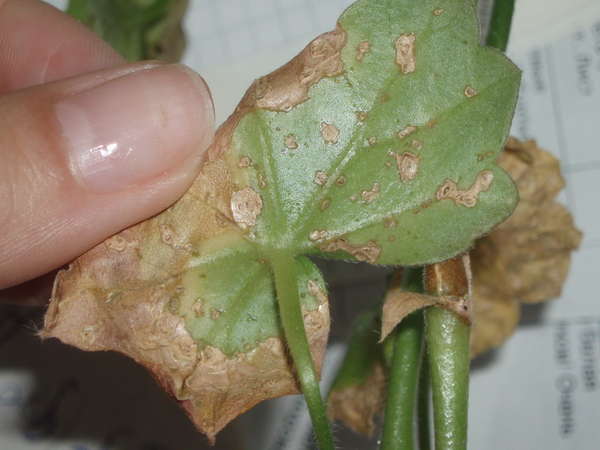
Pelargonium attracts not only people, but also pests. These include:
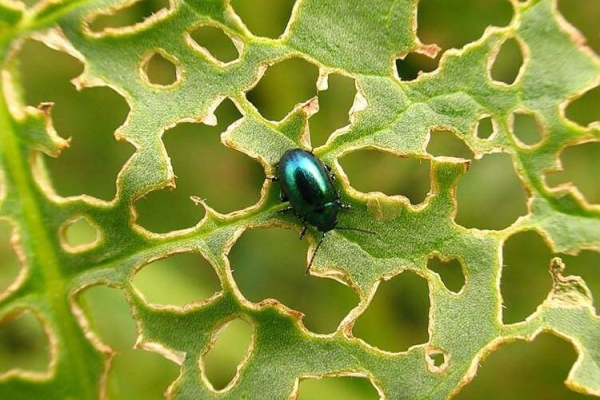
Thus, planting an ivy pelargonium will bring a lot of pleasure, since the flower is decorative, colorful and pompous.
Long hanging shoots will decorate floor and hanging planters and flowerpots.
Caring for this variety of pelargonium is simple.. The sun, fertilizing and the correct watering regimen are all that is needed for the beautiful flowering of ivy pelargonium!
ampelous plants- a great way to decorate a balcony, loggia, gazebo and other structures near the house or in the apartment. Plants that flow from pots or planters in a bright flowering waterfall always attract attention and create a sense of celebration. Ivy geranium or pelargonium is a beautiful and bright plant that is popular for its unpretentiousness, lush and long-term flowering, and the ability to grow quickly. Most often, geraniums are planted on open loggias or terraces in hanging planters or pots.
Ivy geranium (pelargonium) refers to ampelous plant species that are capable of producing rather long shoots hanging down from flowerpots, or curling along the wall. In ordinary geranium, the shoots are short, the leaves are large and rather fragile. In ampelous geranium species, the shoots are quite strong, flexible, able to withstand the weight of the leaves and a large number colors. The leaves of ampelous geranium species are five-pointed, large, smooth, with a matte sheen, without fluff on the surface. In shape, they are very reminiscent of ivy leaves, which loves to curl along vertical surfaces.
Ivy geranium flowers are always bright, large, terry. They are the most important decoration of the plant. Very often, flowers are collected in large inflorescences at the top of the shoot, which gives the flowering plant the appearance of a fluffy multi-colored cloud. Some growers plant several varieties side by side in one box or pots at once. ivy geranium with different colors of flowers. This allows you to create a real extravaganza of color and unusually decorate a loggia or balcony.
| Name | Description |
|---|---|
| An ideal variety for growing on a balcony. The flowers are large, double, collected in bright inflorescences. Shoots grow rapidly, forming a lush basket. The base colors of the variety are bright crimson, purple, dark pink. | |
| This variety is distinguished by an unusual color of leaves: golden frequent veins stand out brightly on a green field. The flowers are semi-double, painted in coral or purple, collected in large inflorescences. During vegetation, the plant quickly forms a compact basket. | |
| This variety outwardly resembles roses due to strongly double large inflorescences. The petals of the flowers of this geranium variety are white. The plant forms a compact bush, which is abundantly strewn with beautiful white flowers. | |
| Another variety that impresses with its abundant flowering. Flowers are white, double, with large quantity petals. The bushes are large due to the abundant branching of the shoots. The highlight of this variety is that in open sunlight, snow-white petals eventually become pink or purple hue which looks very unusual. | |
| This variety impresses with its abundant flowering and beauty. Large double flowers are always collected in large inflorescences. When flowering, the geranium bush looks like a lacy cloud, which can be pink or light lilac. Plants are unpretentious and are characterized by rapid branching of shoots and the formation of a large basket. | |
| The flowers of this variety have a bright and unusual color: white large petals are surrounded by a rich crimson border. This variety of geraniums is classified as compact, since the height of the bush does not exceed 25-30 cm. It blooms very profusely, unpretentious for watering. | |
| The variety is distinguished by a compact bush, which is densely dotted with bright purple flowers. The upper petals of each flower are adorned with purple veins. The variety is characterized by violent flowering even in winter, unpretentious. | |
| This variety is distinguished by very large and full flowers, the upper petals of which are more intense in color than the lower ones. Most often, the flowers of this variety are painted in a rich burgundy color. Differs in abundant flowering, large bushes with wide glossy leaves and branched shoots. | |
| The flowers of this variety of geranium are painted bright red, strongly terry, with large petals. The bush is quite compact, not too tall. The leaves are green, without spotting, the internodes on the shoots are short. | |
| The flower petals of this variety have the most intense color among all types of geraniums - maroon. The variety is characterized by abundant flowering, the bush forms a compact lush basket. The leaves are green, with a glossy sheen. without spotting. |
It's important to know! Ivy geranium grows very fast. In just a few weeks, the plant increases several times, but the root system develops perfectly and functions even in small pots. If the container is too small and there is not enough room for the roots, the flowering plant can shed its inflorescences and slow down growth.
Ivy geranium can be sown at any time of the year if you want to breed this beauty on the windowsills in the apartment. If you want to decorate a balcony or a personal plot with abundant and beautiful inflorescences in a flower pot, then it is advisable to sow the seeds in the spring so that by the beginning of summer the strengthened and grown plants can be transplanted into flower beds.
The seeds of this plant species are quite large, with a strong and reliable shell. To increase germination, seed should be prepared a few days before planting. The first thing to do is to slightly thin the thick shell of the seeds. For these purposes, any sharp or abrasive material is used. You can cut off the surface of the seeds a little with a regular nail file, fine sandpaper is also suitable. This must be done carefully so as not to damage the seed inside the shell.
After scarification (this is what the thinning of the seed coat is called), the seed should be soaked in water. Ideally, it is best to use melted water, but if there is none, then boiled liquid will do.
Seeds are soaked in water cooled to room temperature for a day. The last step in preparing seeds for planting is disinfection. The seeds should be placed in a weak solution of potassium permanganate for half an hour. After this procedure, the seeds are removed from the disinfectant solution and placed on a clean cloth to dry.
While the seeds are soaking, containers with soil should be prepared. You can use ready-made soil, which is sold in specialized stores, peat pots, or make your own soil mixture. The composition of the soil in equal quantities should include peat, sand and soddy land. Homemade soil before planting seeds, it is desirable to disinfect with a weak solution of potassium permanganate.
Seeds should be buried in the ground to a depth of no more than 5 mm. Before planting, the soil should be well moistened.
After the planting procedure, the seed containers are covered with cellophane and placed in a warm place where the air temperature does not fall below 22 degrees.
Watering the seeds should be carried out after 5-6 days. In order not to wash away the soil with the planted material, it is recommended to spray water with a spray gun. It is also important to periodically ventilate the containers with seeds, slightly opening the film for several hours.
Seedlings with geraniums germinate very quickly, literally within 10-14 days. 3 weeks after the appearance of the first leaves of the seedlings, the plants can be transplanted into separate flowerpots. Seedlings should be stopped very carefully, the root system of flowers is quite fragile and can be damaged by rough handling, which will immediately affect the vegetation of plants. It is best to transplant plants with a clod of earth, this will save the roots.
Young plants are recommended to be fed two weeks after transplantation. For normal vegetation, nitrogen fertilizers are used, which should be applied under the root.
Ivy geranium seedlings need a fairly long daylight hours - at least 12 hours. Therefore, if the seeds germinated in February or March, the plants should be provided with additional lighting.
If plants are transplanted into pots or containers in which they will grow permanently, it is worth knowing that at least 1 liter of soil is required per seedling. The distance between plants should be at least 15-17 cm. With proper care, geranium baskets will grow and fill all the free space in a pot or box. It is also necessary to make drainage at the bottom of the container, through which all excess moisture will leave. If the ivy geranium will later be transplanted into open ground, then the volume of the temporary pot is not so important.
Those seedlings that are intended for growing outdoors should be constantly hardened off. For these purposes, pots with plants in warm weather in late April - early May should be taken out into the street, gradually increasing the interval of time spent in the fresh air.
Ivy pelargonium - outdoor cultivation
This variety of geranium needs constant and intense lighting. The plant easily tolerates the sun and lack of moisture, but abundant watering and shade have a bad effect on the vegetation and budding of plants. It is best to plant grown and hardened geranium seedlings in well-lit places so that the plants are provided with constant sunbathing.
Geranium grows well in light and poor soils. On nutrient substrates, the green part of plants develops well, but flowering becomes very moderate. You also need to pay attention to the acidity of the earth, soils with 6.0 - 6.5 pH are suitable for ivy geraniums. At lower or higher rates in plants, root nutrition is disturbed, which affects the growth and budding of the crop. To ensure the desired acidity, you should periodically update the soil near the roots of plants. soil with optimal acidity can be purchased at specialty stores.
During the period of growth and budding, ivy-leaved geranium needs periodic top dressing after 10-12 days. You can use ready-made fertilizers for flowering plants: "Biomaster", "Kemira-Lux", "Pelargovit". Feed should be diluted according to the instructions.
You can also feed the plants with homemade fertilizers. For example, using onion peel. For a large number of flowers, the infusion is prepared as follows: in 5 liters of boiling water, you need to brew 2 large handfuls of onion husks. The infusion should stretch for 2 days. Next, 1.5 liters of fertilizer is diluted in a bucket of clean water and the existing plant bushes are poured with this mixture.
Ivy geranium needs abundant watering, but overflow can have a detrimental effect on the vegetation of plants. Waterlogging the soil can provoke a number of diseases that can be seen visually. These include edema, which is expressed in the appearance of thickening and scars on the green leaves of geranium.
You can get rid of this ailment only by adjusting the mode of watering and drying. The most important rule when watering is to saturate plants with moisture only when the root ball of earth is completely dried. Therefore, before each watering, you should carefully check the soil.
Balcony plants placed on sunny side, you can additionally spray with water, but only in the evening, when direct sunlight is not so intense.
Ivy geranium is perennial plant, which tolerates wintering well in southern latitudes at a temperature of 10-12 degrees. But what if the average winter temperature is very low and the soil freezes completely.
You can try to preserve the plants for the winter, so that in the spring they can be planted again in the ground. To do this, in the fall, completely cut off all the shoots from the geranium bush and carefully dig out the roots with big ball earth. The lump should be placed in a transparent plastic bag and additionally sprinkled with earth. The package should be placed in a lighted place, with an air temperature not higher than 7-8 degrees. It can be a warmed balcony, a glazed loggia. It is not necessary to water the dug cuttings.
In the spring, cuttings with roots are transplanted to the old place and after a while the geranium will give new shoots.
Plants that grew in pots can not be cut. For the winter, it is enough to transfer them to the apartment and place them on well-lit window sills.
Those plants that winter in the apartment need pruning so that a beautiful and even basket of shoots is formed by spring. Pruning is carried out in winter - in December-January or in spring - in March.
With the help of a pruner, all strongly elongated shoots are cut so that a compact bush is formed. Pruning will start the growth of side shoots and due to this, after a while the plant will become dense.
Cut shoots do not need to be thrown away - you can try to germinate them in the ground.
Grow geranium ivy on a balcony or on personal plot not too difficult. The riot of flowers and colors during the flowering period will immediately pay for all the troubles associated with growing this type of flower.
Add site to bookmarks
Geranium is a plant familiar to each of us since childhood. But ivy-leaved geranium can surprise even an experienced grower with its beauty. It is also called ampelous: geranium shoots of this species reach 50-80 cm in length and are able to cascade down without breaking. In hanging pots, on "green walls" and in vertical indoor gardens blooming ivy pelargonium, as this flower is called in the scientific literature, looks impressive and very unusual. Its leaves are smooth and shiny, and bright flowers They come in a variety of colors, so choosing the right one for your interior is not difficult.
Geranium (pelargonium) ivy is unpretentious in care. It needs moderate watering, diffused sunlight and temperatures above 20 degrees.
Pelargonium care at home is simple. This plant is propagated by cuttings, root division and seeds.
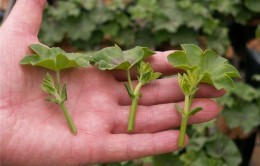
A quick way to grow geraniums is with cuttings that can be cut from an adult plant.
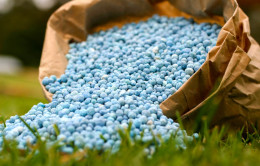
Nitrogen fertilizers are used to feed geraniums.
Home care for ampelous pelargonium has one more feature: in the period after transplantation, it needs nitrogen fertilizers, but it is better to feed an adult plant with fertilizers containing phosphorus and potassium once every 2-3 weeks - this is necessary for lush flowering. The soil is also important, which should include peat, humus and sand in equal quantities.
Pelargoniums need sunlight, moderate watering, a temperature of at least 21 ° C and room for good shoot growth. During the flowering period, inflorescences of red, white, pink or other flowers with a slightly spicy strong smell will appear on each of them.
Among the features of caring for pelargonium, there is one more nuance: this ampelous plant needs to form a bush.
The first shoots are carefully directed down along the walls of the pots, sometimes even attached to the edges. AT favorable conditions ivy pelargonium grows very quickly, so pinching the tops, removing yellowed leaves or wilted inflorescences may be required once a month. The plant is transplanted when the root system becomes short of space in the container intended for it.
If you want to grow pelargonium garden plant, it needs to be planted in containers in February. In 2-3 months, she will be able to take root well and better tolerate climate change. You can decorate balconies and loggias with flowers, decorate gazebos, place planters on the terrace. AT summer period pelargonium can also be planted in open ground as a carpet plant.
In autumn, before the onset of frost, geraniums need to be dug up and transplanted into pots and planters, cutting long shoots. The plant overwinters at home. Ideal for flower growers is the option when pelargonium is grown in containers, which are placed at home in the fall, and re-installed and fixed on your site or balcony in the spring.
Pelargonium (Pelargonium) – favorite plant flower growers. It serves as a decoration for parks, patios, balconies, terraces and other outdoor areas and premises. Pelargonium is valued for its bright, generous, long flowering. Not only its flowers are beautiful, but also the leaves. And how elegant she looks in hanging planter! And although ampelous pelargonium can be quite capricious, it will reward a caring owner like a king.
Ampelous plants are plants for hanging gardens. They have flexible shoots that can both curl along the walls and hang down spectacularly. The ampelous types of geraniums include pelargonium ivy or thyroid (Pelargonium peltatum). She hails from South Africa, where in nature it falls in cascades from the slopes of the hills. Ampelous pelargonium shoots reach a length of 90 cm. It also differs from its zonal (vertically growing) relative in that its leaves are not covered with fluff, but have smooth surface. They are five-lobed, fleshy, green or white-mottled, from 3 cm to 6 cm wide.
Pelargonium ivy-leaved flowers are star-shaped and cactus-shaped. They are located on long peduncles and are collected in umbrella inflorescences up to 8 cm in diameter. In the inflorescence up to 30 flowers, each of which blooms for 5-6 days. Flowers are simple and double, of various shades: white, pink, purple, lilac, two-tone, with a border, strokes, spots ...
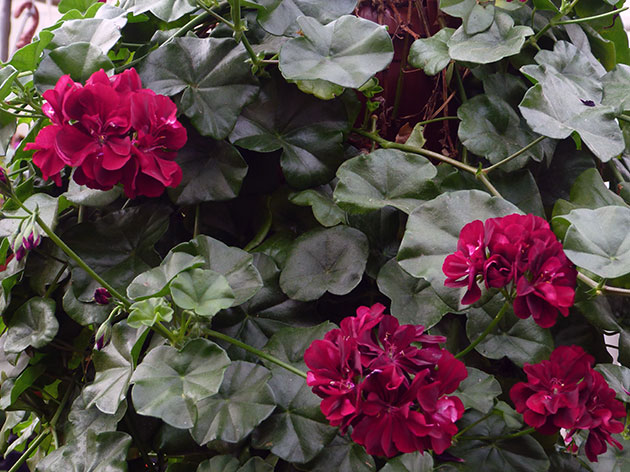
It is photophilous, and (which is a rare advantage) tolerates direct sunlight well. It stoically tolerates dry soil and air, but dies when waterlogged, so it needs good drainage. Not afraid of pelargonium and severe cold, but dies from light frost. Pelargonium does not need to spray the leaves, moreover, it is contraindicated for it, because rot will appear on the leaves, and this will lead to serious diseases.
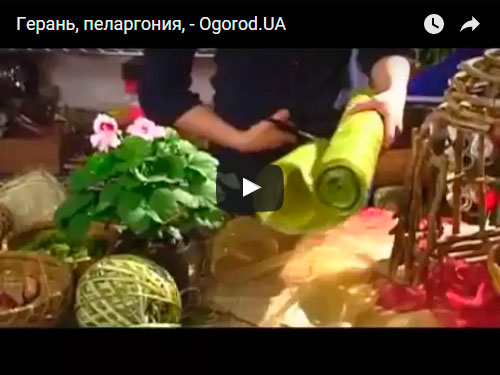
Feed pelargonium ivy during the flowering period (from March to August) you need a weekly complex mineral fertilizer of low concentration. She also likes to drink milk diluted with water. The soil for geraniums needs loamy, light, fertile, high in potassium, but low in nitrogen: with an excess of it, room geranium leaves become larger, but flowering slows down. The earth mixture should be something like this: two parts of soddy land, lowland peat and leafy soil and one part of sand.
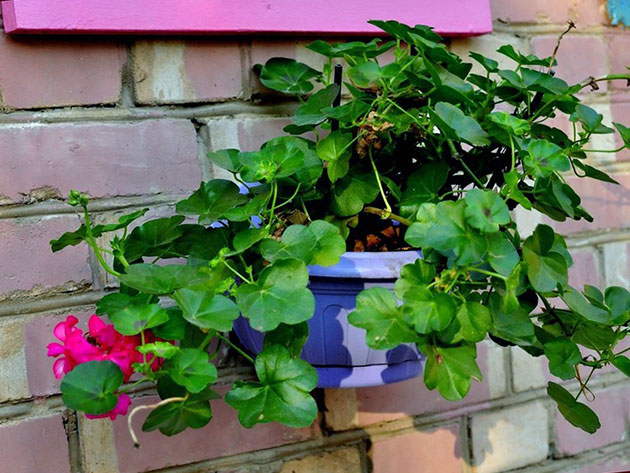
Transplant ampelous geranium you need every two years in the spring in a cramped pot (the roots should be located right next to the walls). If the old pot is still fit for the plant, replace only upper layer soil.
Pelargonium can be grown from seeds, but there are too many nuances to consider. Only experienced flower growers can do this, but they also prefer to propagate pelargonium by cuttings. Pre-dried during the day, cuttings (cuts must be dry) are dipped in coal powder and planted in disinfected (boiling water or in the oven) soil at a distance of 2 cm from each other, compacting the soil on all sides with fingers. The cuttings take root for a month, and if the planting took place in the spring, then in the summer your cutting may bloom.
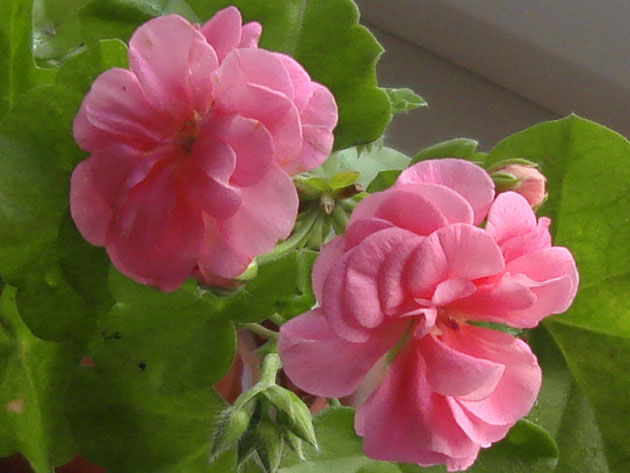
During the dormant period, in winter, if you can place the pelargonium under additional lighting, you can not cut off the ground part. If this is not possible, then cut off all the branches and store it at an air temperature of + 7 ° C in a bright place. In the conditions of wintering pelargonium at room temperature, keep pots as far as possible from heat sources and be prepared for the fact that it will bloom much later, especially her terry varieties. It is rarely necessary to water it during the dormant period, once every 1.5-2 weeks.